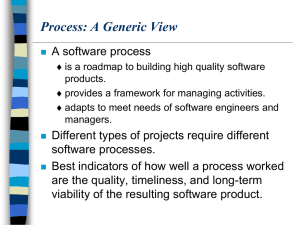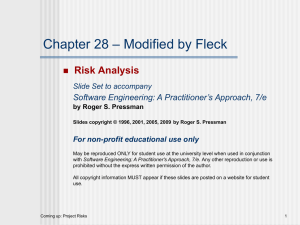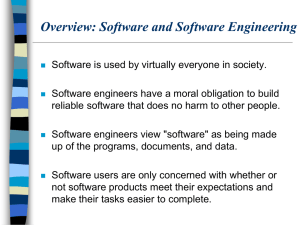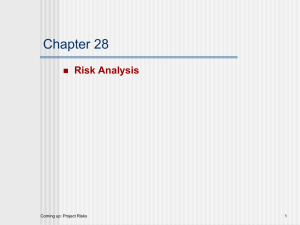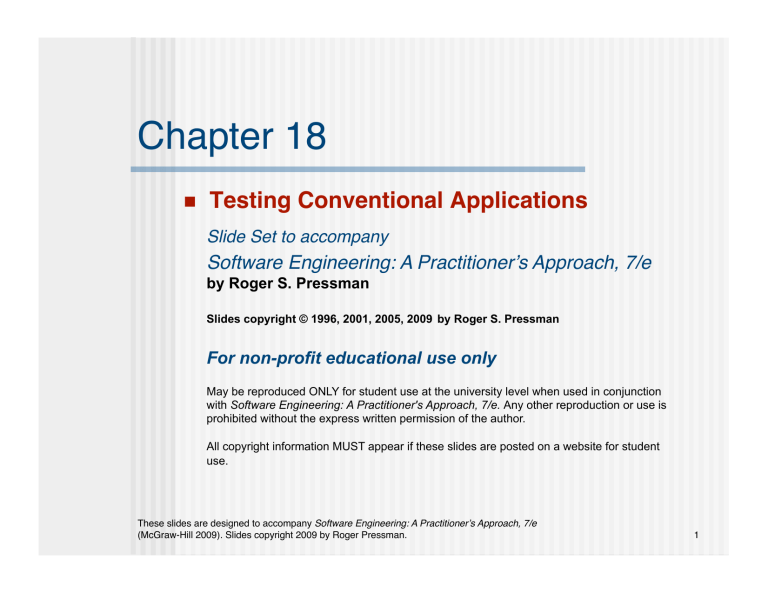
Chapter 18
Testing Conventional Applications
Slide Set to accompany
Software Engineering: A Practitionerʼs Approach, 7/e
by Roger S. Pressman
Slides copyright © 1996, 2001, 2005, 2009 by Roger S. Pressman
For non-profit educational use only
May be reproduced ONLY for student use at the university level when used in conjunction
with Software Engineering: A Practitioner's Approach, 7/e. Any other reproduction or use is
prohibited without the express written permission of the author.
All copyright information MUST appear if these slides are posted on a website for student
use.
These slides are designed to accompany Software Engineering: A Practitionerʼs Approach, 7/e
(McGraw-Hill 2009). Slides copyright 2009 by Roger Pressman.
1
Testability
Operability—it operates cleanly
Observability—the results of each test case are readily
observed
Controllability—the degree to which testing can be
automated and optimized
Decomposability—testing can be targeted
Simplicity—reduce complex architecture and logic to
simplify tests
Stability—few changes are requested during testing
Understandability—of the design
These slides are designed to accompany Software Engineering: A Practitionerʼs Approach, 7/e
(McGraw-Hill 2009). Slides copyright 2009 by Roger Pressman.
2
What is a “Good” Test?
A good test has a high probability of
finding an error
A good test is not redundant.
A good test should be “best of breed”
A good test should be neither too
simple nor too complex
These slides are designed to accompany Software Engineering: A Practitionerʼs Approach, 7/e
(McGraw-Hill 2009). Slides copyright 2009 by Roger Pressman.
3
Internal and External Views
Any engineered product (and most other
things) can be tested in one of two ways:
Knowing the specified function that a product has
been designed to perform, tests can be conducted
that demonstrate each function is fully operational
while at the same time searching for errors in each
function;
Knowing the internal workings of a product, tests
can be conducted to ensure that "all gears mesh," that
is, internal operations are performed according to
specifications and all internal components have been
adequately exercised.
These slides are designed to accompany Software Engineering: A Practitionerʼs Approach, 7/e
(McGraw-Hill 2009). Slides copyright 2009 by Roger Pressman.
4
Test Case Design
These slides are designed to accompany Software Engineering: A Practitionerʼs Approach, 7/e
(McGraw-Hill 2009). Slides copyright 2009 by Roger Pressman.
5
Exhaustive Testing
These slides are designed to accompany Software Engineering: A Practitionerʼs Approach, 7/e
(McGraw-Hill 2009). Slides copyright 2009 by Roger Pressman.
6
Selective Testing
These slides are designed to accompany Software Engineering: A Practitionerʼs Approach, 7/e
(McGraw-Hill 2009). Slides copyright 2009 by Roger Pressman.
7
Software Testing
black-box
methods
white-box
methods
Methods
Strategies
These slides are designed to accompany Software Engineering: A Practitionerʼs Approach, 7/e
(McGraw-Hill 2009). Slides copyright 2009 by Roger Pressman.
8
White-Box Testing
These slides are designed to accompany Software Engineering: A Practitionerʼs Approach, 7/e
(McGraw-Hill 2009). Slides copyright 2009 by Roger Pressman.
9
Why Cover?
These slides are designed to accompany Software Engineering: A Practitionerʼs Approach, 7/e
(McGraw-Hill 2009). Slides copyright 2009 by Roger Pressman.
10
Basis Path Testing
First, we compute the cyclomatic
complexity:
number of simple decisions + 1
or
number of enclosed areas + 1
In this case, V(G) = 4
These slides are designed to accompany Software Engineering: A Practitionerʼs Approach, 7/e
(McGraw-Hill 2009). Slides copyright 2009 by Roger Pressman.
11
Cyclomatic Complexity
These slides are designed to accompany Software Engineering: A Practitionerʼs Approach, 7/e
(McGraw-Hill 2009). Slides copyright 2009 by Roger Pressman.
12
Basis Path Testing
These slides are designed to accompany Software Engineering: A Practitionerʼs Approach, 7/e
(McGraw-Hill 2009). Slides copyright 2009 by Roger Pressman.
13
Basis Path Testing Notes
These slides are designed to accompany Software Engineering: A Practitionerʼs Approach, 7/e
(McGraw-Hill 2009). Slides copyright 2009 by Roger Pressman.
14
Deriving Test Cases
Summarizing:
Using the design or code as a foundation, draw a
corresponding flow graph.
Determine the cyclomatic complexity of the resultant
flow graph.
Determine a basis set of linearly independent paths.
Prepare test cases that will force execution of each
path in the basis set.
These slides are designed to accompany Software Engineering: A Practitionerʼs Approach, 7/e
(McGraw-Hill 2009). Slides copyright 2009 by Roger Pressman.
15
Graph Matrices
A graph matrix is a square matrix whose size
(i.e., number of rows and columns) is equal to
the number of nodes on a flow graph
Each row and column corresponds to an
identified node, and matrix entries correspond
to connections (an edge) between nodes.
By adding a link weight to each matrix entry,
the graph matrix can become a powerful tool
for evaluating program control structure during
testing
These slides are designed to accompany Software Engineering: A Practitionerʼs Approach, 7/e
(McGraw-Hill 2009). Slides copyright 2009 by Roger Pressman.
16
Control Structure Testing
Condition testing — a test case design method
that exercises the logical conditions contained
in a program module
Data flow testing — selects test paths of a
program according to the locations of
definitions and uses of variables in the program
These slides are designed to accompany Software Engineering: A Practitionerʼs Approach, 7/e
(McGraw-Hill 2009). Slides copyright 2009 by Roger Pressman.
17
Data Flow Testing
The data flow testing method [Fra93] selects test paths of
a program according to the locations of definitions and
uses of variables in the program.
Assume that each statement in a program is assigned a
unique statement number and that each function does not
modify its parameters or global variables. For a statement
with S as its statement number
• DEF(S) = {X | statement S contains a definition of X}
• USE(S) = {X | statement S contains a use of X}
A definition-use (DU) chain of variable X is of the form [X, S,
S'], where S and S' are statement numbers, X is in DEF(S)
and USE(S'), and the definition of X in statement S is live
at statement S'
These slides are designed to accompany Software Engineering: A Practitionerʼs Approach, 7/e
(McGraw-Hill 2009). Slides copyright 2009 by Roger Pressman.
18
Loop Testing
These slides are designed to accompany Software Engineering: A Practitionerʼs Approach, 7/e
(McGraw-Hill 2009). Slides copyright 2009 by Roger Pressman.
19
Loop Testing: Simple Loops
These slides are designed to accompany Software Engineering: A Practitionerʼs Approach, 7/e
(McGraw-Hill 2009). Slides copyright 2009 by Roger Pressman.
20
Loop Testing: Nested Loops
These slides are designed to accompany Software Engineering: A Practitionerʼs Approach, 7/e
(McGraw-Hill 2009). Slides copyright 2009 by Roger Pressman.
21
Black-Box Testing
These slides are designed to accompany Software Engineering: A Practitionerʼs Approach, 7/e
(McGraw-Hill 2009). Slides copyright 2009 by Roger Pressman.
22
Black-Box Testing
How is functional validity tested?
How is system behavior and performance tested?
What classes of input will make good test cases?
Is the system particularly sensitive to certain input
values?
How are the boundaries of a data class isolated?
What data rates and data volume can the system
tolerate?
What effect will specific combinations of data have on
system operation?
These slides are designed to accompany Software Engineering: A Practitionerʼs Approach, 7/e
(McGraw-Hill 2009). Slides copyright 2009 by Roger Pressman.
23
Graph-Based Methods
Directed link
object
#1
object
#2
(link weight)
Undirected link
Parallel links
Node weight
(value
)
object
#
3
(a)
new
file
menu select generates
(generation time < 1.0 sec)
is represented as
allows editing
of
document
window
Attributes:
contains
document
tex
t
background color: white
text color: default color
or preferences
(b)
These slides are designed to accompany Software Engineering: A Practitionerʼs Approach, 7/e
(McGraw-Hill 2009). Slides copyright 2009 by Roger Pressman.
24
Equivalence Partitioning
These slides are designed to accompany Software Engineering: A Practitionerʼs Approach, 7/e
(McGraw-Hill 2009). Slides copyright 2009 by Roger Pressman.
25
Sample Equivalence Classes
These slides are designed to accompany Software Engineering: A Practitionerʼs Approach, 7/e
(McGraw-Hill 2009). Slides copyright 2009 by Roger Pressman.
26
Boundary Value Analysis
These slides are designed to accompany Software Engineering: A Practitionerʼs Approach, 7/e
(McGraw-Hill 2009). Slides copyright 2009 by Roger Pressman.
27
Comparison Testing
Used only in situations in which the reliability of
software is absolutely critical (e.g., humanrated systems)
Separate software engineering teams develop
independent versions of an application using the
same specification
Each version can be tested with the same test data
to ensure that all provide identical output
Then all versions are executed in parallel with realtime comparison of results to ensure consistency
These slides are designed to accompany Software Engineering: A Practitionerʼs Approach, 7/e
(McGraw-Hill 2009). Slides copyright 2009 by Roger Pressman.
28
Orthogonal Array Testing
Used when the number of input parameters is
small and the values that each of the
parameters may take are clearly bounded
Z
Y
Z
X
One input item at a time
Y
X
L9 orthogonal array
These slides are designed to accompany Software Engineering: A Practitionerʼs Approach, 7/e
(McGraw-Hill 2009). Slides copyright 2009 by Roger Pressman.
29
Model-Based Testing
Analyze an existing behavioral model for the software or
create one.
Traverse the behavioral model and specify the inputs
that will force the software to make the transition from
state to state.
Recall that a behavioral model indicates how software will
respond to external events or stimuli.
The inputs will trigger events that will cause the transition
to occur.
Review the behavioral model and note the expected
outputs as the software makes the transition from state
to state.
Execute the test cases.
Compare actual and expected results and take corrective
action as required.
These slides are designed to accompany Software Engineering: A Practitionerʼs Approach, 7/e
(McGraw-Hill 2009). Slides copyright 2009 by Roger Pressman.
30
Software Testing Patterns
Testing patterns are described in much the
same way as design patterns (Chapter 12).
Example:
• Pattern name: ScenarioTesting
• Abstract: Once unit and integration tests have been
conducted, there is a need to determine whether the
software will perform in a manner that satisfies users.
The ScenarioTesting pattern describes a technique for
exercising the software from the user’s point of view. A
failure at this level indicates that the software has
failed to meet a user visible requirement. [Kan01]
These slides are designed to accompany Software Engineering: A Practitionerʼs Approach, 7/e
(McGraw-Hill 2009). Slides copyright 2009 by Roger Pressman.
31
